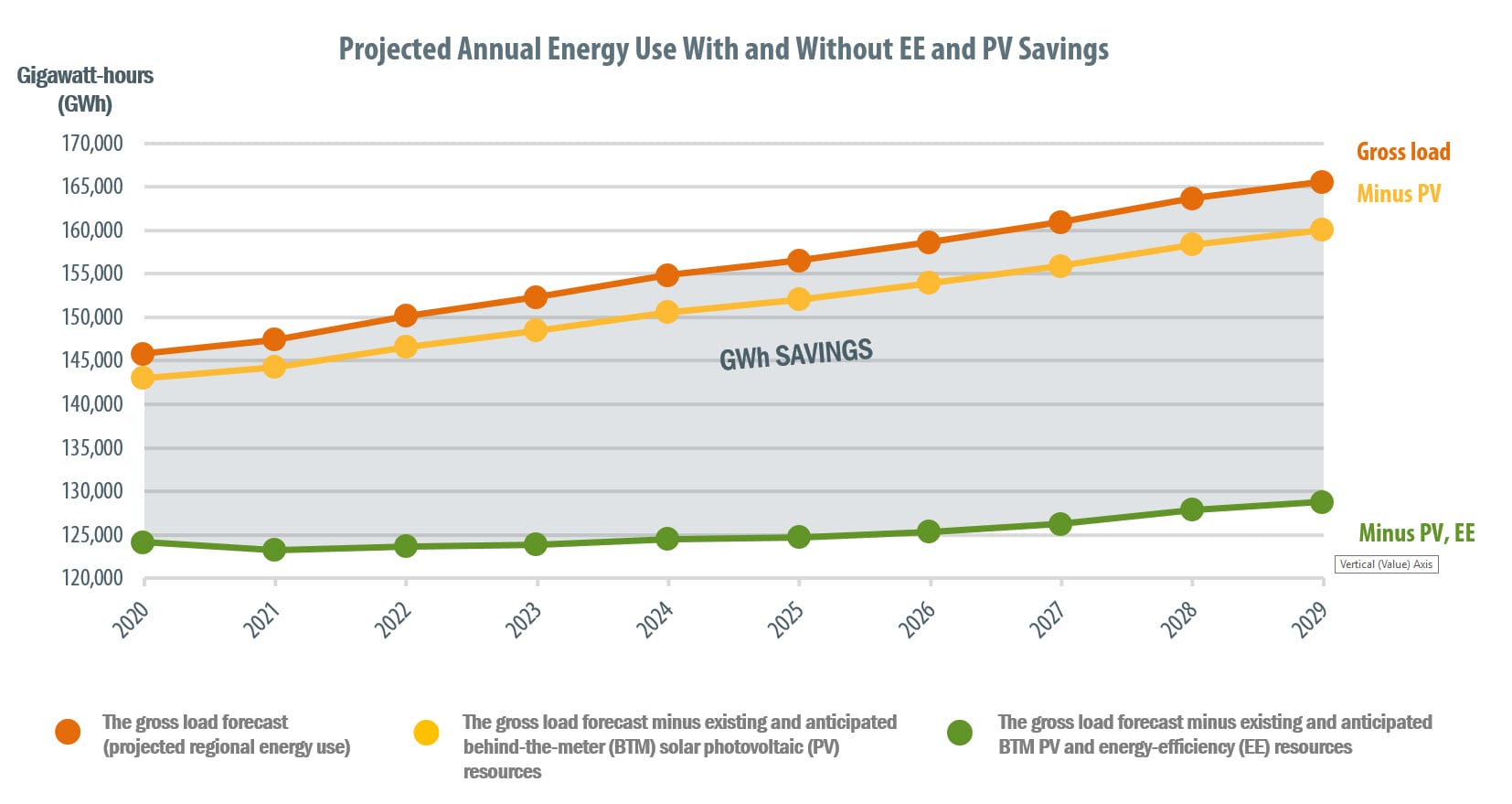ISO-NE publishes 2020 forecast of capacity, energy, loads, and transmission (CELT report)
 Energy use and peak demand will increase slightly over next 10 years
Energy use and peak demand will increase slightly over next 10 years
On April 30, 2020, the ISO published the 2020-2029 Forecast Report of Capacity, Energy, Loads, and Transmission (CELT). The report is a primary source for assumptions used in ISO system planning and reliability studies. The 2020 CELT projects that both energy usage and peak demand will increase slightly in New England over the 10-year period. The primary factors for this increase are the additional energy and loads resulting from the new electrification forecast for electric vehicles (EVs) and air-source heat pumps (ASHPs).
The CELT provides a snapshot of the New England power system, including:
- The number of megawatts (MW) with capacity supply obligations, as well as the total generating capability of resources in the region
- The breakdown of the region’s generators by fuel type
- A link to the listing of transmission projects proposed, planned, and under construction
- The long-term forecast for energy consumption and peak demand, including the contributions of energy efficiency, behind-the-meter solar facilities, and for the first time, a ten-year forecast for energy and demand changes due to the deployment of light-duty EVs and ASHPs
CELT projections for 2020 to 2029
The ISO develops the gross long-term forecast for electricity demand using state and regional economic forecasts, years of weather history in New England, and the EV/ASHP forecasts. Results of both the ISO’s energy-efficiency (EE) forecast and solar photovoltaic (PV) forecast are applied to the gross forecast to develop a net long-term forecast.
Gross forecast, not including EE, behind-the-meter PV:
- Overall electricity use in New England is expected to grow 1.4% annually over the 10-year period, from the expected 145,882 gigawatt-hours (GWh) this year to 165,603 GWh in 2029
- Peak demand under typical summer peak weather conditions (the “50/50” forecast) is expected to rise annually at a rate of 0.9%, from 29,224 megawatts (MW) this year to 31,550 MW in summer 2029 (peak demand is a measure of the highest amount of electricity used in a single hour)
- Peak demand under extreme summer peak weather (the “90/10” forecast), such as an extended heat wave, pushes the gross forecast for peak demand up to 31,182 MW in 2020 and 33,760 MW in 2029
- Winter peak demand under typical winter peak weather conditions (the “50/50” forecast) is expected to rise by an average 1.1% annually, from 23,373 MW in 2021 to 25,687 MW in 2030
- Winter peak demand under extreme winter peak weather (the “90/10” forecast) is forecasted to rise annually as well, from 24,013 MW in 2021 to 26,442 MW in 2030
Net forecast, including latest EE, behind-the-meter PV forecasts:
- Overall electricity use is expected to increase, by 0.4% annually, from 124,184 GWh this year to 128,781 GWh in 2029. This is an increase from the 2019 CELT, which reported an average annual decrease of -0.4%.
- EE is projected to save the region 18,840 GWh in 2020 and up to 31,284 GWh in 2029
- PV is projected to produce about 2,858 GWh of total annual grid energy savings in 2020, rising to about 5,538 GWh in 2029
- Peak demand under typical summer peak weather conditions is expected to fall slightly, by -0.2% over the 10-year period, from 25,125 MW this year to 24,755 MW in 2029.
- The net forecast includes peak demand reductions of 787 MW this year and rising to 1,062 MW in summer 2029 as a result of behind-the-meter PV
- Peak demand under extreme summer peak weatheris expected to remain essentially flat, with a slight annual decline, from 27,083 MW in 2020 to 26,965 MW in 2029
- Transportation electrification from EVs is forecasted to contribute 282 MW to peak demand in 2029
- Winter peak demand is forecasted to increase an average of about 0.1% annually, under both normal and extreme conditions. For normal winter weather, net peak demand is expected to increase from 20,166 MW this year to 20,334 MW in 2029; for extreme winter weather, the net peak is forecasted to increase from 20,806 MW this year to 21,089 MW in 2029
- Transportation electrification from EVs is forecasted to contribute 414 MW to the winter peak in 2029
- Heating electrification is forecasted to contribute 661 MW to the winter peak in 2029


New for 2020
The CELT report has gone through a variety of additions, revisions, and changes this year to reflect the ever-evolving face of the bulk electric system. Changes include the following:
- Standardized the design and made format changes to increase readability and to support the report’s use in an electronic format
- A detailed introductory paragraph precedes each table to help increase the reader’s understanding of the data and to decrease reliance on footnotes
- The report contains embedded Word files to ensure that all text displays properly
- Merged the Introduction section and the Preface to eliminate redundancies
- In Sections 1.1 and 1.2, included subtotals for energy efficiency and distributed generation megawatts
- In Sections 1.3 and 1.4, summarized “fuel type only” for summer and winter capability
- Added Section 1.7, relating to the electrification forecast, which addresses recent growth in emerging electrification technologies (i.e., electric cars, heat pumps)
- Presented information on primary natural gas pipeline connection by asset in Section 2.3 and not in Appendix C.1
- Merged and minimized the appendices for ease of use and to increase access to up-to-date information
Please direct any comments or questions about the CELT report to ISO-NE Customer Support at custserv@iso-ne.com.
Learn more
- For more information on the 2020 CELT, detailed forecasts and models are available on the Load Forecast webpage
- Get key statistics on New England’s electricity use and resource mix
- Track load in real time via ISO Express
- Categories
- Recent Publications & Events
- Tags
- demand resources, energy efficiency, forecast, forward capacity market, solar



